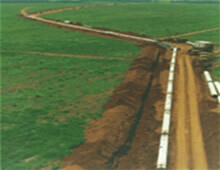The Bolivia-Brazil Gas Pipeline is a type of transport route that connects Bolivia and Brazil through a pipeline, which has 3,150 km along its entire route, being 557 km inside Bolivia and 2,593 km on the ground Brazilian. The total cost of this work was $2 billion.
This project had its construction started in 1997, two years later it was already partially operating. The prospects are that in 2010 its operating capacity will be expanded, with the aim of increasing the supply of natural gas in the Brazilian market.

The gas pipeline starts in Santa Cruz de La Sierra (Bolivia) to Canoas (Rio Grande do Sul- Brazil), crossing the states of Mato Grosso do Sul, São Paulo, Paraná and Santa Catarina, cutting 135 counties.
The implementation of this pipeline is extremely important for the energy sector in Brazil, promoting an increase in the availability of natural gas in the national market. Here in Brazil, the gas circulation route is under the responsibility of Transportadora Brasileira Gasoduto Brasil-Bolivia S/A (TBG). Perspectives are for increases in production capacity for the coming years, an important factor in view of the need for this product in Brazil.
By Eduardo de Freitas
Graduated in Geography
Brazil School Team
Fuels - geography - Brazil School
Source: Brazil School - https://brasilescola.uol.com.br/geografia/gasoduto-brasilbolivia.htm
